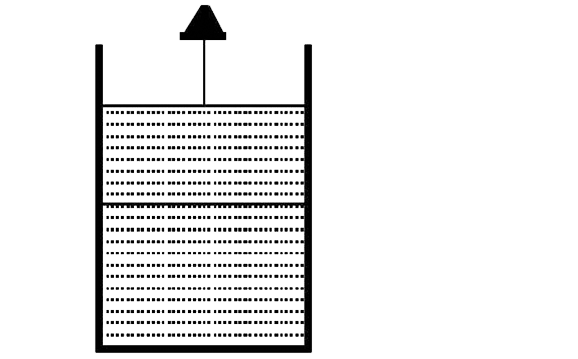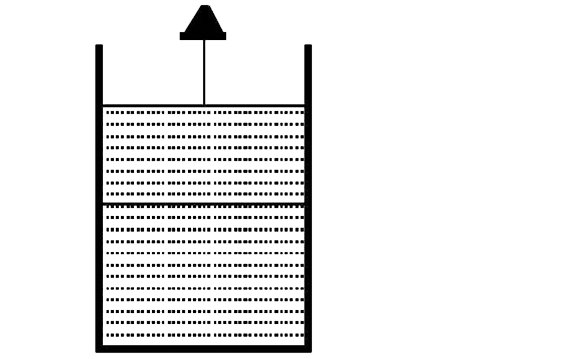There are some passeger inside a stationary railway compartment. The centre of mass of the compartment itself (without the passngers) is C1 while the centre of mass of the compartment plus passengers system is C2 if passenger move about inside the comparment
both C1 and C2 will move with respect to the groud
neither C1 nor C2 will move with respect to the ground
C1 will move but C2 will be stationary with respect to the ground
C2 will move but C1 will be stationary with respect to the ground
The correct Answer is:c
Step by step video, text & image solution for There are some passeger inside a stationary railway compartment. The centre of mass of the compartment itself (without the passngers) is C_(1) while the centre of mass of the compartment plus passengers system is C_(2) if passenger move about inside the comparment by Physics experts to help you in doubts & scoring excellent marks in Class 12 exams.
Updated on:21/07/2023Topper's Solved these Questions
Similar Questions
In a stationary railway compartment, there are several passengers. If they start moving in the compartment, will CM of the compartment change ? Will the CM of the system of compartment and passengers change ?
View SolutionThe sphere shown in figue lies on a rough plane when a particle of mass m travbelling at a speed v0 collides and sticks with it. If the line of motion of the particle is at a distance h above the plane, find a. the linear speed o the combine dsystem just after teh collision b. the angular speed of the system about the centre of the sphere just the collistion c. the value of h for which the sphere starts pure rolling on the plane Assume that the mass M of the sphesre is large compared to teh mass of the partcle so that is large compared toteh mass of the particle so that teh centre of mass of the combined system is not appreciably shifted from the centre of the sphere.

View Solution
Knowledge Check
There are some passengers inside a stationary railway compartment. The track is frictionless. The centre of mass of the compartment itself (without the passengers) is C1, while the centre of mass of the 'compartment plus passengers' system is C2. If the passengers move about inside the compartment along the track.
ABoth C1 and C2 will move with respect to the groundBNeither C1 nor C2 will move with respect to the groundCC1 will move but C2 will be stationary with respect to the groundDC2 will move but C1 will be stationary with respect to the groundTwo bodies of masses 1 kg and 2 kg, separated by 6 m are rotating about the centre of mass of the system. The moment of inertia of the system is
A12kgm2B24kgm2C36kgm2D6kgm2Two objects of masses 1kg and 2kg separated by a distance of 1.2m are rotating about their centre of mass. Find the moment of inertia of the system
A0.96kgm2B0.48kgm2C0.83kgm2D0.72kgm2
A man stands at one end of a boat which is stationary in water. Neglect water resistance. The man now moves to the other end of the boat and again becomes stationary. The centre of mass of the man plus boat system will remain stationary with respect to water.
View SolutionA man stands at one end of a boat which is stationary in water. Neglect water resistance. The man now moves to the other end of the boat and again becomes stationary. The centre of mass of the 'man plus boat' system will remain stationary with respect to water
View SolutionIn the figure, a container is shown to have a movable (without friction) piston on top. The container and the piston are all made of perfectly insulated material allowing no heat transfer between outside and inside the container. The container is divided into two compartments by a rigid partition made of a thermally conducting material that allows slow transfer of heat. The lower compartment of the container is filled with 2 moles of an ideal monatomic gas at 700K and the upper compartment is filled with 2 moles of an ideal diatmoic gas at 400K. The heat capacities per mole of an ideal monatomic gas are CV=32R,CP=52R, and those for an ideal diatomic gas are CV=52R,CP=72R,

Now consider the partition to be free to move without friction so that the pressure of gasses in both compartments is the same. The total work done by the gases till the time they achives equilibrium will be
View SolutionAs observed in the laboratory system , a 6 MeV proton is incident on a stationary 12 C target. The velocity of centre of mass of the system is (Take mass of proton to be 1 amu)
View SolutionIn the figure, a container is shown to have a movable (without friction) piston on top. The container and the piston are all made of perfectly insulated material allowing no heat transfer between outside and inside the container. The container is divided into two compartments by a rigid partition made of a thermally conducting material that allows slow transfer of heat. The lower compartment of the container is filled with 2 moles of an ideal monatomic gas at 700K and the upper compartment is filled with 2 moles of an ideal diatmoic gas at 400K. The heat capacities per mole of an ideal monatomic gas are CV=32R,CP=52R, and those for an ideal diatomic gas are CV=52R,CP=72R,

Consider the partition to be rigidly fixed so that it does not move. When equilibrium is achieved, the final temperature of the gasses will be
View Solution
